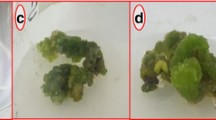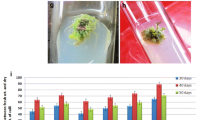Abstract
Caesalpinia bonduc (L.) Roxb. [Family: Fabaceae (Caesalpiniaceae)], a traditional medicinal plant, has profound therapeutic value and is recently used for the treatment of polycystic ovary syndrome in India. Its seeds and kernels rich in bioactive homoisoflavonoids like bonducellin are reported to possess antioxidant, anti-bacterial, anti-inflammatory, anticancer, anti-estrogenic, and anti-androgenic properties. Considering such therapeutic significance, in vitro propagation of C. bonducella warrants action for enhanced production of secondary metabolites as harvesting seeds for long might pose an extinction threat. The present study aimed to introduce and optimize a protocol for inducing leaf callus and eliciting enriched synthesis of bonducellin compound. Of different combinations of plant growth regulators (PGRs), 2,4-dichloro phenoxy acetic acid (2,4-D) and 6-benzyl amino purine (BAP) at a low concentration of 0.5 and 0.2 mg/L, respectively, induced profuse biomass (2.12 g FW at 20 dpi) in MS medium with 98.6% frequency. Abiotic elicitors, glutathione (GSH), and salicylic acid (SA) at 10 µM and 20 µM concentrations were amended to the above callus initiation medium. The content of bonducellin, analyzed using HPLC with the chemically synthesized standard, increased significantly (5.8 mg/g DW) in the callus elicited with 20 µM glutathione for 15 days which is 1.48-fold higher as compared to that in the untreated control (3.9 mg/g DW). However, elicitation with 20 µM salicylic acid resulted in a lower level of bonducellin (2.38 mg/g DW). The present finding provides an insight into the potential of GSH as a prospective elicitor of homoisoflavonoid, bonducellin, in C. bonducella leaf callus and opens avenues toward fulfilling the rising commercial requirements of novel anti-PCOS and metabolic drugs in the future.
Key message
First report on leaf-derived callus induction in Caesalpinia bonducella and enhanced accumulation of bonducellin in the callus elicited by glutathione.






Similar content being viewed by others
References
Armero J, Requejo R, Jorrín J, López-Valbuena R, Tena M (2001) Release of phytoalexins and related isoflavonoids from intact chickpea seedlings elicited with reduced glutathione at root level. Plant Physiol Biochem 39:785–795. https://doi.org/10.1016/S0981-9428(01)01299-2
Beygi Z, Nezamzadeh Z, Rabiei M, Mirakhorli N (2021) Enhanced accumulation of trigonelline by elicitation and osmotic stresses in fenugreek callus culture. Plant Cell Tissue Organ Cult 147:169–174. https://doi.org/10.1007/s11240-021-02055-w
Billah M, Islam R, Khatun H et al (2013) Antibacterial, antidiarrhoeal, and cytotoxic activities of methanol extract and its fractions of Caesalpinia bonducella (L.) Roxb leaves. BMC Complement Altern Med. https://doi.org/10.1186/1472-6882-13-101
Cheruvathur M, Britto J, Thomas T (2010) Callus induction and shoot regeneration from epicotyl explants of ethnomedicinally important Caesalpinia bonduc (L.) Roxb. Iran J Biotechnol 8:263–269
Domecq P, Prutsky G, Mullan J et al (2013) Adverse effects of the common treatments for polycystic ovary syndrome: a systematic review and meta-analysis. J Clin Endocrinol 98:4646–4654. https://doi.org/10.1210/jc.2013-2374
Farjaminezhad R, Zare N, Asghari-Zakaria R, Farjaminezhad M (2013) Establishment and optimization of cell growth in suspension culture of Papaver bracteatum: a biotechnology approach for thebaine production. Turk J Biol 37:689–697. https://doi.org/10.3906/biy-1304-54
Gai Y, Jiao J, Wang X et al (2019) Correction to: elicitation of Isatis tinctoria L. hairy root cultures by salicylic acid and methyl jasmonate for the enhanced production of pharmacologically active alkaloids and flavonoids. Plant Cell Tissue Organ Cult 137:417. https://doi.org/10.1007/s11240-019-01610-w
Gayathri K, Supriya V, Palaniappan N (2021) Nutritional composition and sensory evaluation of Phytoestrogen-Rich supplement for women with PCOS. Int J Nutr Pharmacol Neurol Dis 11:303–308. https://doi.org/10.4103/ijnpnd.ijnpnd_29_21
Gomez D, Noctor G, Knight R, Foyer H (2004) Regulation of calcium signalling and gene expression by glutathione. J Exp Biol 55:1851–1859. https://doi.org/10.1093/jxb/erh202
Gowthami R, Sharma N, Pandey R, Agrawal A (2021) Status and consolidated list of threatened medicinal plants of India. Genet 68:2235–2263. https://doi.org/10.1007/s10722-021-01199-0
Hayat Q, Hayat S, Irfan M, Ahmad A (2010) Effect of exogenous salicylic acid under changing environment: a review. Environ Exp Bot 68:14–25. https://doi.org/10.1016/j.envexpbot.2009.08.005
Kandasamy V, Balasundaram U (2021) Caesalpinia bonduc (L.) Roxb. as a promising source of pharmacological compounds to treat Poly Cystic Ovary Syndrome (PCOS): a review. J Ethnopharmacol. https://doi.org/10.1016/j.jep.2021.114375
Liu Y, Harinantenaina L, Brodie J et al (2013) Bioactive compounds from Stuhlmannia moavi from the Madagascar dry forest. Bioorg Med Chem 21:7591–7594. https://doi.org/10.1016/j.bmcl.2013.xx
Masoumian M, Arbakariya A, Syahida A, Maziah M (2011) Flavonoids production in Hydrocotyle bonariensis callus tissues. J Med Plant Res 5:1564–1574
Mathur A, Mathur K, Gangwar A et al (2010) Anthocyanin production in a callus line of Panax sikkimensis Ban. In Vitro Cell Dev Biol Plant 46:13–21. https://doi.org/10.1007/s11627-009-9253-3
Maughan C, Pasternak M, Cairns N et al (2010) Plant homologs of the Plasmodium falciparum chloroquine-resistance transporter, PfCRT, are required for glutathione homeostasis and stress responses. Proc Natl Acad Sci USA 107:2331–2336. https://doi.org/10.1073/pnas.0913689107
Radman R, Saez T, Bucke C, Keshavarz T (2003) Elicitation of plants and microbial cell systems. Biotechnol Appl Biochem 37:91. https://doi.org/10.1042/ba20020118
Rao K, Fang H, Tzeng M (2005) Anti-inflammatory activities of flavonoids isolated from Caesalpinia pulcherrima. J Ethnopharmacol 100:249–253. https://doi.org/10.1016/j.jep.2005.02.039
Robbins P, Hartnoll J, Morris P (1991) Plant Cell Reports Phenylpropanoid defence responses in transgenic Lotus corniculatus 1. Glutathione elicitation of isoflavan phytoalexins in transformed root cultures. Plant Cell Rep 10:59–62. https://doi.org/0.1007/BF00236457
Roy S, Kumari N, Gupta S et al (2013) 7-Hydroxy-(E)-3-phenylmethylene-chroman-4-one analogues as efflux pump inhibitors against Mycobacterium smegmatis mc2 155. Eur J Med Chem 66:499–507. https://doi.org/10.1016/j.ejmech.2013.06.024
Sachan K, Sachan K, Hussain A (2010) An investigation to antioxidant activity of Caesalpinia Bonducella seeds. Ann Pharm Pharm Sci 1:88–91
Sagharyan M, Ganjeali A, Cheniany M, Kouhi M (2020) Optimization of callus induction with enhancing production of phenolic compounds production and antioxidants activity in callus cultures of Nepeta binaloudensis jamzad (Lamiaceae). Iran J Biotechnol 18:47–55. https://doi.org/10.30498/IJB.2020.2621
Santhoshkumar S, Krishna V, Pradeepa K et al (2012) Direct and indirect method of plant regeneration from root explants of Caesalpinia bonduc (L.) Roxb.—a threatened medicinal plant of western ghats. Indian J Exp Biol 50:910–917
Senda K, Ichi Ogawa K (2004) Induction of PR-1 Accumulation accompanied by runaway cell death in the lsd1 mutant of Arabidopsis is dependent on glutathione levels but Independent of the Redox State of glutathione. Plant Cell Physiol. https://doi.org/10.1093/pcp/pch179
Shukla S, Mehta A, John J et al (2009) Antioxidant activity and total phenolic content of ethanolic extract of Caesalpinia bonducella seeds. Food Chem Toxicol 47:1848–1851. https://doi.org/10.1016/j.fct.2009.04.040
Singh V, Chauhan S, Singh M et al (2014) Establishment of an efficient and rapid method of multiple shoot regeneration and a comparative phenolics profile in in vitro and greenhouse-grown plants of Psophocarpus tetragonolobus (L.) DC. Plant Signal Behav 9:1–9. https://doi.org/10.4161/15592316.2014.970443
Singh T, Sharma U, Agrawal V (2020) Isolation and optimization of plumbagin production in root callus of Plumbago zeylanica L. augmented with chitosan and yeast extract. Ind Crops Prod. https://doi.org/10.1016/j.indcrop.2020.112446
Tajik S, Zarinkamar F, Soltani M, Nazari M (2019) Induction of phenolic and flavonoid compounds in leaves of saffron (Crocus sativus L.) by salicylic acid. Sci Hortic. https://doi.org/10.1016/j.scienta.2019.108751
Thirumurugan A, Senthil Kumar T, Ranjitha Kumari D (2020) Influence of plant growth regulators on plant regeneration from epicotyl and hypocotyl explants of Caesalpinia bonduc (L.) Roxb—an ethnomedical plant. J Appl Hortic 22:80–84. https://doi.org/10.37855/jah.2020.v22i01.1
Verpoorte R, Contin A, Memelink J (2002) Biotechnology for the production of plant secondary metabolites. Phytochem Rev 1:13–25. https://doi.org/10.1023/A:1015871916833
Vidya Bharathi R, Swetha S, Neerajaa J et al (2017) An epidemiological survey: effect of predisposing factors for PCOS in indian urban and rural population. Middle East Fertil Soc J 22:313–316. https://doi.org/10.1016/j.mefs.2017.05.007
Zakaria A, Hour H, Zare N (2011) Callus production and regeneration of the medicinal plant Papaver orientale. Afr J Biotechnol 10:11152–11156. https://doi.org/10.5897/ajb11.204
Zare N, Valizadeh, Tohidfar M et al (2009) Selection of regenerative genotypes from iranian alfalfa cultivars. J Food Agric Environ 7:567–572
Zhou G, Wu Y (2006) Development and application of medicinal plant tissue cultures for production of drugs and herbal medicinals in China. Nat Prod Rep 23:789–810. https://doi.org/10.1039/b610767b
Acknowledgements
The authors greatly acknowledge the instrumentation facility maintained by the Department of Biotechnology, SRM Institute of Science and Technology for HPLC analysis. UB is thankful to Prof. P. Jayaraman, taxonomist for the validation of Caesalpinia bonducella.
Funding
This study was funded by SRM Institute of Science and Technology, Kattankulathur, Chennai, India.
Author information
Authors and Affiliations
Contributions
UB contributed to the study conception and design. Material preparation, data collection and analysis were performed by KM. The first draft of the manuscript was written by KM and corrected by UB. BB synthesized bonducellin compound and VK assisted with the HPLC analysis. All authors read and approved the final manuscript.
Corresponding author
Ethics declarations
Conflict of interest
The authors declare that they have no conflict of interest.
Additional information
Communicated by K. X. Tang.
Publisher’s Note
Springer Nature remains neutral with regard to jurisdictional claims in published maps and institutional affiliations.
Rights and permissions
Springer Nature or its licensor (e.g. a society or other partner) holds exclusive rights to this article under a publishing agreement with the author(s) or other rightsholder(s); author self-archiving of the accepted manuscript version of this article is solely governed by the terms of such publishing agreement and applicable law.
About this article
Cite this article
Karthikeyan, M., Baskar, B., Kandasamy, V. et al. Glutathione elicits enhanced biosynthesis of bonducellin, a homoisoflavonoid, in Caesalpinia bonducella leaf callus. Plant Cell Tiss Organ Cult 155, 57–65 (2023). https://doi.org/10.1007/s11240-023-02551-1
Received:
Revised:
Accepted:
Published:
Issue Date:
DOI: https://doi.org/10.1007/s11240-023-02551-1




